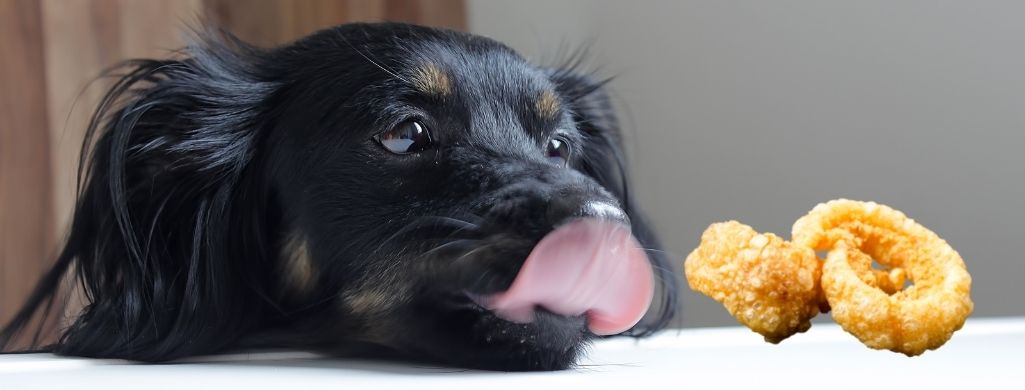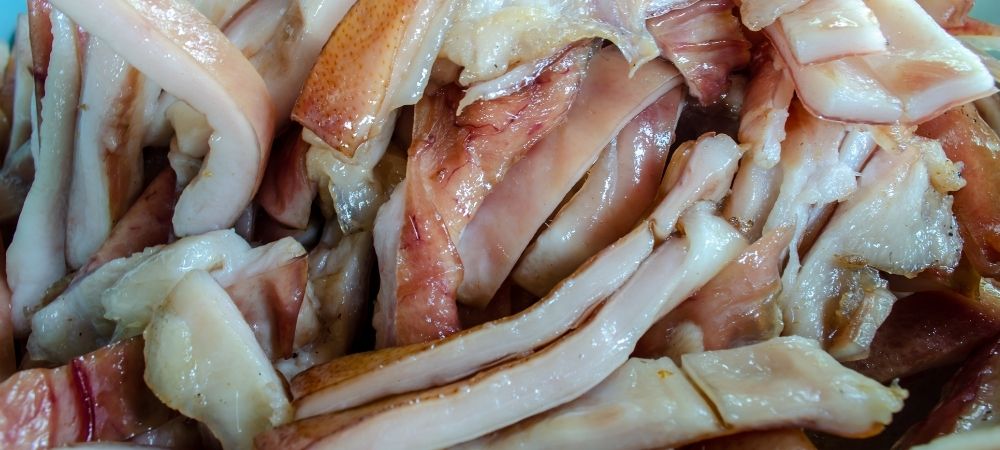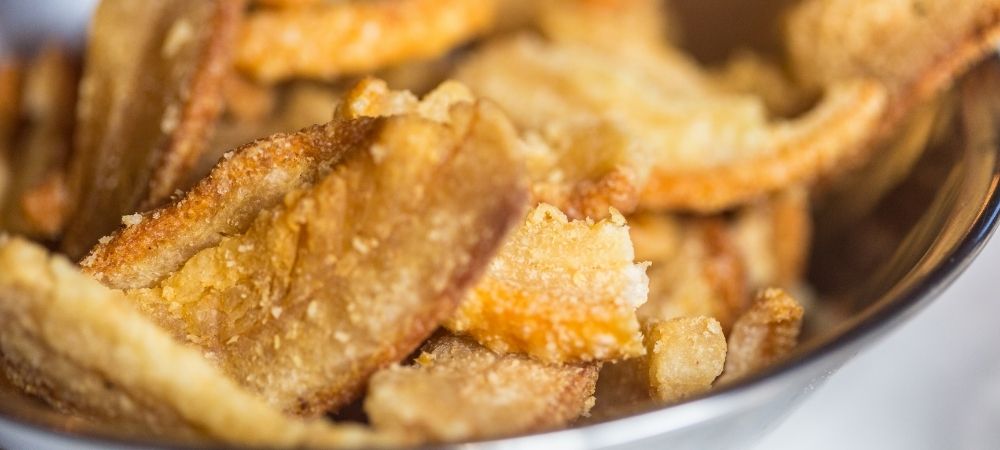
Dogs have a very different digestive tract than humans, so some human foods are safe for them, while others can be toxic.
You’re wondering about pork rinds probably because you enjoy them and want to share them with your pet. It’s understandable — pork rinds can be delicious, and their smell is often enticing to dogs.
But you should know right off the bat that hardly ever can dogs eat pork rinds.
There are some exceptions and alternatives — read on to find out why your four-legged companion shouldn’t eat pork rinds and what to do if they did.
Can Dogs Eat Pork Rinds?
No, dogs shouldn’t eat pork rinds because of fat content, salt, spices, and preparation techniques. All of these can be dangerous and even toxic to dogs.
One ounce of pork rinds can have over 28% of your dog’s daily allowance for calories. Half of these calories are fat. This is a considerable amount and can cause obesity or pancreatitis.
Besides, pork rinds contain 520 mg of sodium per ounce, which is 80% of the daily allowance for dogs. If a dog eats pork rinds regularly, it can lead to salt poisoning and further complicate health issues.
Pork rinds are usually made with pork skin and fat trimmings, so they contain lots of cholesterol too. Pork rinds are either deep-fried or baked to make them crispy. But underneath is a thick fat layer. While cholesterol doesn’t affect dogs as badly, high fat is a whole other issue.
Fat can damage kidneys or arteries in your pet’s body over time. If you let your dog eat pork rind as a treat, it will lead to obesity, weight gain, and associated health problems.
Furthermore, some pork rinds can contain spices that are harmful to dogs — like nutmeg, or garlic, and onion. These are highly toxic to your pooch and can cause loads of issues, even the death of a pet.
Hardly ever can dogs eat pork rinds, so it’s best to avoid feeding them to your dogs altogether!

Can Dogs Eat Raw Pork Rind?
Raw pork rind is not a suitable dog treat. In fact, it is more dangerous than fried pork rind. Raw pork can be contaminated with trichinella spiralis, a parasite that causes trichinosis.
The symptoms of this illness in dogs include diarrhea, vomiting, and muscle pain. Treatment can be long and expensive.
Adding to that, a raw pork rind can be a choking hazard to dogs.
If you’re determined to give your pet raw pork rinds, make sure they are free of mold and cooked thoroughly until crispy dry. Then peel off any fat or skin before feeding them.
But the best alternative is not giving pork rinds to them at all!
Can Dogs Eat Fried Pork Rinds?
If you fry pork rinds, they also become high in fat and sodium, which is terrible for your dog.
Fried pork rinds, like any fatty food, are dangerous if you regularly feed them to your dog. They can lead to weight gain, obesity, and associated health issues.
Fried pork rinds and high-fat content can also cause pancreatitis, a painful and severe condition that can lead to a pet’s death if left untreated. These are among the worst food treats you can feed your dog.
Can Dogs Eat Spicy Pork Rinds?
Spicy pork rinds can cause digestive problems as well, so it’s best to avoid them. Why? Spicy pork rinds are made with spices that irritate the stomach of dogs, which will cause stomach problems.
If dogs eat pork rinds with spices, they may develop an upset stomach, diarrhea, or vomiting.
Besides, a pork rind’s seasonings can contain undisclosed ingredients like nutmeg, cinnamon sugar, or garlic and onion, which are downright toxic to dogs.
It’s best to avoid spicy pork rinds and feed your dog something else they can chew on, digest quickly, and not cause any health problems down the road.
Is Pork Skin OK for Dogs?
Pork skins are fried and typically coated in salt or spices to make them crispy, which is not healthy for dogs.
Pork skins can cause stomach issues like diarrhea and vomiting because of the spices used in this process. At worst, they could contain spices that are toxic to dogs, like garlic and onion.
Additionally, pork skins are very high in salt, and the increased sodium intake can lead to salt poisoning.
If dogs eat pork skins regularly, they can cause weight gain and obesity because of the high fat content in pork.
Pork skins also pose a choking hazard for dogs, so steer away from feeding pork skin to your dog!
Is Cooked Pig Skin Good for Dogs?
Cooked pig skin is not suitable for dogs because it’s just fried animal fat, and your dog can’t chew them properly or digest them.
When you cook pork skin, they become high in fat and sodium, which is bad for your dog. High fat and sodium content in your dog’s system can cause pancreatitis or intestinal obstruction if your pooch swallows them whole.
If fed regularly, they can lead to weight gain, obesity, and even salt toxicity.
While some dog owners use cooked pig skin as a chewing toy for teeth, it is not suitable for dog’s nutrition.
Can Dogs Eat Smoked Pork Skin?
Smoking meat is used to preserve it and to add flavor. Additionally, it helps prevent trichinosis, a parasitic infection.
When you smoke pork rinds, all of the fat in the original cut is retained. It becomes high in sodium and bad for your dog’s health if they swallow them whole without chewing first.
It’s better not to feed your pet pork rinds or anything produced from pork skin because of the potential health problems.
Every time your dog eats something they’re not supposed to, watch them closely for a few hours. Be on the lookout for possible health issues such as vomiting or diarrhea.
Can Dogs Eat Pork Scratchings?
You may have heard the term pork scratchings and wondered what it’s about. Pork scratchings are a UK term for pork rinds, so the same rules apply — they are not good for your dog.
Pork scratchings pose a myriad of health risks to dogs: they’re high in fat and sodium, salt poisoning is a possibility (because of the sodium content), and they can cause pancreatitis.
Pork scratchings are also made with spices that irritate the stomach of dogs, which will cause gastric issues like vomiting or diarrhea.
Can Dogs Eat Pork Crackling?
Pork crackling is another name for crispy pork skin, which is not suitable for your dog. A pig’s skin remains on a pork meat joint — and Is then either fried or baked in an oven to make it crispy.
While baking is better than frying, both ways of cooking pork crackling make it high in fat and salt, which is bad for your dog.
High fat and sodium content in your dog’s system can cause pancreatitis or intestinal obstruction if he swallows them whole. If fed regularly, they can lead to weight gain, obesity, and even salt toxicity.
Can Dogs Eat Cueritos?
Cueritos is the name for pork rinds in Mexican, Venezuelan and Spanish cuisine, so no, you shouldn’t feed cueritos to your dog.
Cueritos are made from cooked pig skin, and they’re not good for your dog to eat.
Cueritos are high in fat which can cause pancreatitis if your dog eats them whole.
Symptoms of consuming cueritos include lethargy, vomiting, and diarrhea. If you notice any of these symptoms, take your dog to the vet immediately.
Can Dogs Eat Pork Rinds That Are Store-Bought?
Store-bought pork rinds are high in fat and sodium, which can cause pancreatitis or intestinal obstruction if your dog swallows them whole without chewing first.
Furthermore, they can contain additives and harmful ingredients to your dog. Make sure to check the list of ingredients if your dog ate pork rinds that are store-bought.
Can Dogs Eat Pork Ribs?
Pork ribs are unsuitable for dogs because they can splinter and be a choking hazard when swallowed or potentially cause pancreatitis if your dog eats them whole without chewing first.
It’s best to avoid feeding your pet pork rinds or anything produced from pork skin.
Can Dogs Eat Pork Fat?
No, dogs shouldn’t eat pork fat for several reasons.
Pork fat is very high in saturated fatty acids and bad for your dog’s health if your furry friend eats it whole without chewing first.
High fat content can lead to weight gain, obesity, pancreatitis, and other health problems for your pet.
If the pork fat is undercooked, it may contain Trichinella spiralis larvae and lead to trichinosis.
If it is cooked, the fat content increases, potentially leading to pancreatitis.
Avoid feeding your dog pork rinds or anything produced from pork skin since it will not do them any good in the long run.

What Happens if a Dog Eats Pork Rinds?
A few pork rinds usually won’t harm your dog, but be on the lookout for any symptoms of a health problem.
If a large amount is consumed or not chewed well before swallowing, there’s a chance that it can cause pancreatitis.
Symptoms to look out for include lethargy, vomiting, and diarrhea. In mild cases, vomiting and diarrhea resolve in a few hours. If they don’t, take your furry friend to the vet immediately.
Additionally, pork rinds can cause salt poisoning, a severe medical issue for your furry companion.
Symptoms of Salt Poisoning
When dogs eat pork rinds regularly, it can cause salt toxicity. In that case, the dog’s body releases its water to mitigate the effects of salt.
The symptoms can include:
- Seizures
- Kidney disease
- Dehydration
- Tremors
- Muscle weakness
- Lethargy
- Coma
Salt toxicity is a severe condition and can lead to the death of a pet. If you notice the symptoms and know that the dog ingests more salt than usual, call the vet or immediately take the dog to a vet clinic. IV fluid therapy is often the only treatment that can help.
Steps to Take in Case of Salt Poisoning
There are several steps you can take if you notice the symptoms of salt toxicity:
Step 1: Call the vet immediately.
Step 2: Make sure your dog has access to fresh water at all times.
Step 3: Do not expose your dog to extreme temperatures, as this will cause further dehydration.
Step 4: Minimize the dog’s physical activity.
Step 5: Don’t feed them human food leftovers.
Step 6: Talk to your vet about potentially introducing some probiotics after restoring your pet’s health.
Either way, it’s best to take the dog to a vet clinic immediately.
What Are the Alternatives to Pork Rinds?
There are many alternatives to your dog eating pork rinds.
One option is a high-quality protein, low carbohydrate diet. Chicken or beef are the usual good choices. The raw food diet is also very popular among dog owners.
Or, you could make homemade pork rinds at home, so you know exactly what your dog is eating.
Alternatively, you can look up safe and pet-approved treats for your dog.
Make sure you consult with your vet before making any dietary changes for your pet. Some dogs may have allergies or other special needs that require a specific type of food.
Just Say No to Pork Rinds
Can dogs eat pork rinds? In short, they really should not.
Dogs love pork rinds, mainly because of the smell. But eating pork rinds regularly is not good because of multiple risks and problems they could cause.
High fat and high sodium content, the risk of developing trichinosis, pancreatitis, and salt poisoning, in addition to potentially toxic ingredients — these are all very concerning and can seriously harm your pet’s health.
Pork rinds aren’t particularly good for humans either, but that’s another story. For now, make sure this food is far out of your dog’s reach at all times.

